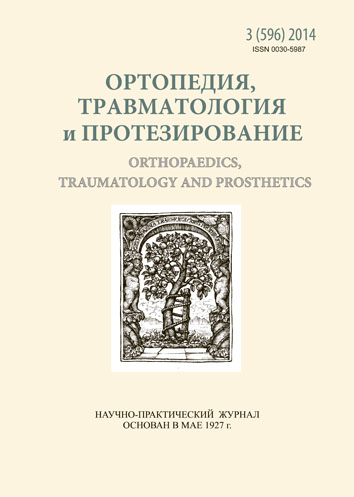Computed tomographic assessment of healing of long bone defect in rats after implantation in its cavity of osteoplastic material based on β-tricalcium phosphate
DOI:
https://doi.org/10.15674/0030-5987201435-9Keywords:
Chronos™, β-tricalcium phosphate, reparative osteogenesis, Hounsfield unitAbstract
Objective: with using of the computed tomography to investigate compact bone (diaphysis) of femurs of the rats after implantation of osteoplastic material Chronos™, to improve knowledge about the dynamics and the rate of its biodegradation and integration, as well as the site of density in defect area and adjacent maternal bone, and evaluate postoperative complications. Methods: The experiment was conducted on 30 white laboratory male rats (8 months, weight (250 ± 10) g). Under ketamine anesthesia in the middle third of the femoral shaft using a portable drill spherical cutter at low speed with cooling we created defect with diameter of 2.5 mm toward a medullary canal and filled it with osteoplastic material Chronos™ (Synthes, Switzerland) without any rigid fixation. After 15, 30, 60, 120 and 180 days after surgery we investigated injured femurs implanted with the stuff on the 16-slice spiral computed tomograph «TOSHIBA Activion». Results: There was absence of any signs of bone rarefaction of the maternal bone at all stages of observation. 15 days after implantation structure of Chronos™ was maintained but since a 30-day there were detected some signs of resorption of osteoplastic material and their subsequent increase, and its replacement by bone tissue. Relatively high optical density of regenerate was established on the 15th day of the experiment and its equation with the absolute optical density of maternal bone, and even its predominance to 120–180 days. In the last period of the experiment it was established approximation of the relative optical density of regenerate to 100 % while the absence of restoring the original shape and integrity of bone so far as in the cortical bone hardly noticeable deepening or newly formed tough endosteal callus still remained.
References
- Arsenyev I. G. Experimental morphological study of clinical application of degradable Bioimplant in treatment of fractures and pseudarthrosis of the long bones: dis. ... сandidate medical sciences: 14.00.22, 14.00.15 / Igor Gennadevich Arsenyev. — M., 2007 — 200 p.
- Grigoryan A. S. Problems of integration of implants in bone tissue (theoretical aspects) / A. S. Grigoryan, A. K. Toporkova. — M.: Technosphere, 2007 — 128 p.
- Merkulov V. N. Violation consolidation bones for fractures in children and adolescents. Methods of diagnosis and treatment / V. N. Merkulov, A. I. Dorohin, N. P. Omelyanenko. — M.: «Sainz PRESS», 2009 — 264 p.
- Paraskevich V. L. Dental implantology: basic theory and practice / Paraskevich V. L. — 3rd ed. — M.: «Medical Information Agency», 2011 — 400 p.
- Strang D. G. Secrets computed tomography. Thorax, abdomen, pelvis / D. G. Strang, V. Dogra. — M.; Petersburg: BINOM-Dialect, 2012 — 448 р.
- Behaviour of chronOs™ Inject in metaphyseal bone defects of distal radius fractures: Tissue reaction after 6–15 months / Rohit Arora, Stefan Milz, Christoph Sprecher [et al.] // Injury. — 2012. — Vol. 43 (10). — P. 1683–1688.
- ß-Tricalcium phosphate as a bone substitute for-dorsal spinal fusion in adolescent idiopathic scoliosis — preliminary result of a prospective clinical study / M. Muschik, R. Ludwig, S. Halbhübner [et al.] // Eur. Spine J. — 2001. — Vol. 10 (2). — P. 178–184.
- ß-TCP bone graft substitutes in a bilateral rabbit tibial defect model / W. R. Walsh, F. Vizesi, D. Michael [et al.] // Biomaterials. — 2008. — Vol. 29 (3). — P. 266–271.
- Pochon J. P. Knochenersatzplastiken mit tricalciumphosphat keramik im kindesalter / J. P. Pochon // Aktuelle Probleme in Chirurgie und Orthopädie. — 1990. — Vol. 36. — P. 146.
- Porous tricalcium phosphate and transforming growth factor used for anterior spine surgery / T. Steffen, T. Stoll, T. Arvinte [et al.] // Eur. Spine J. — 2001. — Vol. 10. — P. 132–140.
- Stoll T. New aspects in osteoinduction / T. Stoll // Mat.-wiss. U. Werkstofftech. — 2004. — Vol. 35 (4). — P. 198–202.
- Tricalcium phosphate granules or rigid wedge preforms in open wedge high tibial osteotomy: a radiological study with a new evaluation system / W. L. Van Hemert, K. Willems, P. G. Anderson [et al.] // Knee. — 2004. — Vol. 11 (6). — P. 451–456.
- Wheeler D. Grafting of massive tibial subchondral bone defects in a caprine model using — tricalcium phosphate versus autograft / D. Wheeler // J. Orthop Trauma. — 2005. — Vol. 19 (2). — P. 85–91.
Downloads
How to Cite
Issue
Section
License
Copyright (c) 2014 Olexiy Korenkov

This work is licensed under a Creative Commons Attribution 4.0 International License.
The authors retain the right of authorship of their manuscript and pass the journal the right of the first publication of this article, which automatically become available from the date of publication under the terms of Creative Commons Attribution License, which allows others to freely distribute the published manuscript with mandatory linking to authors of the original research and the first publication of this one in this journal.
Authors have the right to enter into a separate supplemental agreement on the additional non-exclusive distribution of manuscript in the form in which it was published by the journal (i.e. to put work in electronic storage of an institution or publish as a part of the book) while maintaining the reference to the first publication of the manuscript in this journal.
The editorial policy of the journal allows authors and encourages manuscript accommodation online (i.e. in storage of an institution or on the personal websites) as before submission of the manuscript to the editorial office, and during its editorial processing because it contributes to productive scientific discussion and positively affects the efficiency and dynamics of the published manuscript citation (see The Effect of Open Access).














